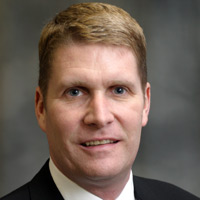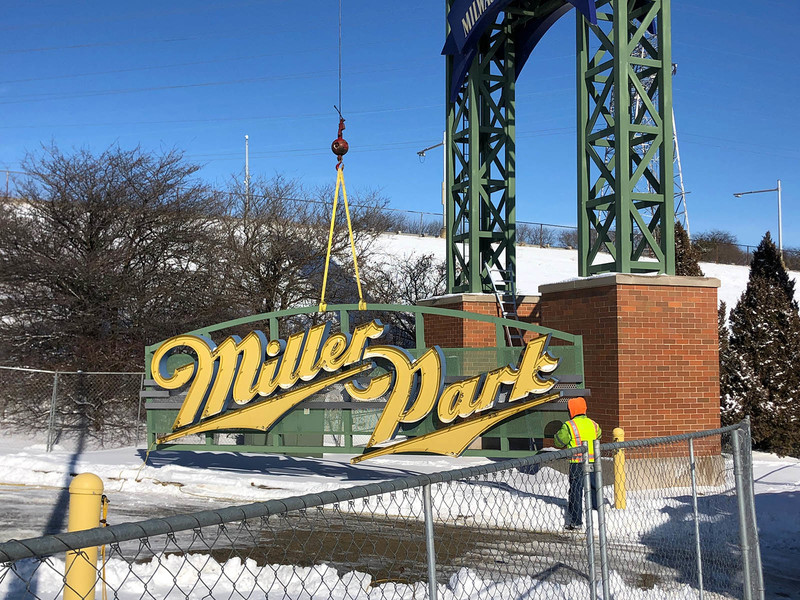Following a thrill ride season of high-decibel, through-the-roof baseball racket, Miller Park earned a lengthy dose of off-season serenity. Likewise, the stadium playing field is also in winter hibernation mode at the moment.
If you're lunching at Friday's Front Row Sports Grill, grab a window seat and check out the view. The grass isn't always greener on the other side ... it's whiter.
Miller Park is covered in one giant Snuggie.
"It's like a plastic tarp you could buy at a store, but a little different," explained Mike Boettcher, grounds manager at Miller Park. "It's a green and clear plastic woven together to help block out the sunlight a little bit and also preserve the moisture that does go through down into the field."
Boettcher and his crew pulled the enormous winter tarp on the turf shortly after the Cardinals ended the Brewers' World Series jaunt. The cover-every-blade-of-grass blanket doesn't suffocate the lawn because it's permeable, allowing moisture and some sun to sneak through.
But why cover it at all? Fans watch their backyard lawn get buried in snow and somehow bounce back each spring.
"With the length of our season, starting the first part of April each year, we're putting down the covers to manage the leaf blades on top of the surface," said Boettcher. "We're not allowing it to go through all the natural processes that most homeowner lawns go through throughout the winter months, so we're just kind of managing the top of the grass a little bit more than everybody else does with the covers."
It takes someone like Boettcher, with a degree from the University of Wisconsin in Horticulture, to find a solution to dodge the brunt of Mother Nature's winter wrath. But Miller Park doesn't convert into some makeshift off-season greenhouse. There are still elements of the annual Wisconsin winter wonderland in play.
"We've pretty much stopped all growth underneath the covers," said Boettcher. "We are letting everything freeze up ... we don't have any supplemental heat underneath the field. The field goes through the normal freeze/thaw process just like everyone else's lawn does throughout the winter. We're not blocking out any frost or anything like that, so the grass plants have already reached dormancy."
At stake is the healthy return of the Miller Park infield and outfield. Made up of 100-percent Kentucky Bluegrass, the brand is standard operating sod for most natural athletic fields, according to Boettcher, who added that Kentucky Bluegrass is a cold-season grass that can take the pounding not only delivered by the winter months, but the punishment delivered by Major League Baseball players.
"There are many traits about Kentucky Bluegrass that we use for the selection, but the highlighted one would be that it is wear tolerant ... its ability to withstand the traffic of the baseball game, as well as its ability to survive in a retractable roof structure with a non-full sunlight environment," said Boettcher.
Ah yes, the roof. Another chess match Boettcher and his crew must carefully gauge to know when the optimal time might be to seal the surface shut. Expect to see Miller Park closed up any day now in an effort to limit a monster blizzard that might consume and bury the diamond below.
And when is Milwaukee's playing field back in play?
"Until it looks like we're ready to start waking up here for the spring, when the temperatures start to rise and we need to get the grass woken up and ready to go for the season," answered Boettcher.
That alarm clock goes off in the vicinity of late February, and by early March ("weather permitting" adds Boettcher), chores are on tap as the march to wake up the field in time for Opening Day begins in earnest.
"I've lived in this climate my entire life and it's definitely a challenge when it comes to growing grass in certain areas," said the 27-year-old Boettcher, who grew up on a farm in Fairchild, Wis.
Miller Park is Boettcher's baby now. Last season, he saw his role and responsibilities increase with the declining health of longtime Head Groundskeeper Gary Vanden Berg, who fought a courageous battle with cancer before passing away during the Brewers' October post-season.
"The biggest thing I will never forget, he taught me never be satisfied with what you're doing," said Boettcher, who interned for Vanden Berg and the Brewers in 2004 before returning in 2009 as a landscape assistant, later leading to a promotion as Vanden Berg's first assistant. "Take pride in what you're doing and the product you're putting out, but always analyze it and always work to do projects better.
"He always pushed for making the field better, making himself better, making his managers, assistants and crew better. There was always that drive."
Bob currently does play-by-play at Time Warner Cable Sports 32, calling Wisconsin Timber Rattlers games in Appleton as well as the area high school football and basketball scene. During an earlier association with FS Wisconsin, his list of teams and duties have included the Packers, Bucks, Brewers and the WIAA State Championships.
During his life before cable, Bob spent seven seasons as a reporter and producer of "Preps Plus: The Milwaukee Journal Sentinel High School Sports Show."
And the joke is, Bob has a golf shirt from all four Milwaukee television stations. Sad, but true: Bob has had sports and news anchor/reporter/producer stints at WTMJ, WISN, WDJT and WITI.
His first duty out of college (UW-Oshkosh) was radio and TV work in Eau Claire. Bob spent nearly a decade at WEAU-TV as a sports director and reporter.
You may have heard Bob's pipes around town as well. He has done play-by-play for the Milwaukee Mustangs, Milwaukee Iron, and UW-Milwaukee men's and women's basketball. Bob was the public address announcer for five seasons for both the Marquette men and women's basketball squads. This season, you can catch the starting lineups of the UW-Milwaukee Panther men's games with Bob behind the mic.
A Brookfield Central graduate, Bob's love and passion for sports began at an early age, when paper football leagues, and Wiffle Ball All Star Games were all the rage in the neighborhood.







